
Pac-Man, originally called Puck Man in Japan, is a 1980 maze action video game developed and released by Namco for arcades. In North America, the game was released by Midway Manufacturing as part of its licensing agreement with Namco America. The player controls Pac-Man, who must eat all the dots inside an enclosed maze while avoiding four colored ghosts. Eating large flashing dots called "Power Pellets" causes the ghosts to temporarily turn blue, allowing Pac-Man to eat them for bonus points.

Ms. Pac-Man is a 1982 maze arcade video game developed by General Computer Corporation and published by Midway. It is the first sequel to Pac-Man (1980) and the first entry in the series to not be made by Namco. Controlling the title character, Pac-Man's wife, the player is tasked with eating all of the pellets in an enclosed maze while avoiding four colored ghosts. Eating the larger "power pellets" lets the player eat the ghosts, who turn blue and flee.

Pac-Man Vs. is a 2003 maze video game developed by Nintendo EAD and published by Namco for the GameCube. In the game, one player takes control of Pac-Man, who must eat all of the pellets in the maze, while the others control the ghosts to try to catch them. The objective is to be the first to reach a set number of points, selected before the game begins. The player controlling Pac-Man uses the Game Boy Advance to play, while the others use the television to control the ghosts. The game requires the GameCube - Game Boy Advance link cable in order to play.
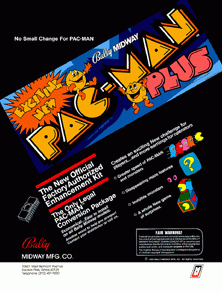
Pac-Man Plus is an arcade game that was released by Bally Midway on March 13, 1982, and it is the third title in the Pac-Man series of games.

Jr. Pac-Man is an arcade video game developed by General Computer Corporation and released by Bally Midway on August 13, 1983. It has the same gameplay as prior entries in the series, but the maze in Jr. Pac-Man scrolls horizontally and has no escape tunnels. The bonus item which moves around the maze changes dots into a form which slows Jr. Pac-Man as they are being eaten.

Super Pac-Man is a 1982 maze chase arcade game developed and published by Namco. It was distributed in North America by Midway Games. Super Pac-Man is Namco's take on a sequel to the original Pac-Man; Midway had previously released Ms. Pac-Man, which Namco had little involvement with. Toru Iwatani returns as designer.
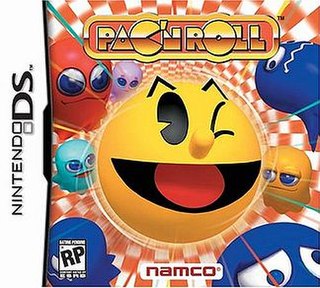
Pac 'n Roll is a 2005 platform video game developed and published by Namco for the Nintendo DS. It stars a 3D Pac-Man as the user rolls him through the playing field using the touchscreen. The game sees Pac-Man; who has been turned into a ball, go on a journey with his new fairy companion Krystal, to save his friends from Golvis and the ghosts.

Pac-Man World is a platform video game developed and published by Namco for the PlayStation. Controlling Pac-Man, the player must complete each of the game's six worlds by collecting a certain amount of pellets to open up an exit door. The plot follows Pac-Man's enemies, the ghosts, crashing his 20th birthday and kidnapping his friends and family to bring them to their homeland of Ghost Island — with his birthday in ruins and his family in trouble, Pac-Man sets out to rescue them and defeat the ghosts.

Namco Classic Collection Vol. 2 is a 1996 compilation arcade game developed and published by Namco. It is a collection of four of Namco's popular games: Pac-Man (1980), Rally-X (1980), New Rally-X (1981) and Dig Dug (1982). Alongside the original games, three new "Arrangement" games based on each game are included.

Pac-Man: Adventures in Time is a 2000 maze video game in the Pac-Man series developed by Creative Asylum and Mind's Eye Productions, and published by Hasbro Interactive, in collaboration with Namco. The game follows a formula similar to the original arcade game, while expanding on it with new features. In the game, Pac-Man travels through various time periods using Professor Pac-Man's time machine to recover pieces of an ancient artifact.

Pac-Man is a 1982 maze video game developed and published by Atari, Inc. under official license by Namco, and an adaptation of the 1980 hit arcade game of the same name. The player controls the title character, who attempts to consume all of the wafers while avoiding four ghosts that pursue him. Eating flashing wafers at the corners of the screen will cause the ghosts to turn temporarily blue and flee, allowing Pac-Man to eat them for bonus points.
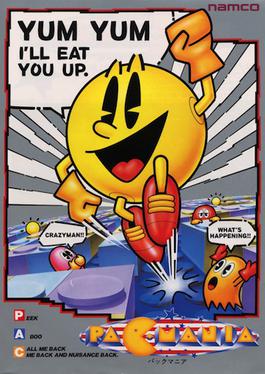
Pac-Mania is a cavalier perspective maze game that was developed and released by Namco for arcades in 1987. In the game, the player controls Pac-Man as he must eat all of the dots while avoiding the colored ghosts that chase him in the maze. Eating large flashing "Power Pellets" will allow Pac-Man to eat the ghosts for bonus points, which lasts for a short period of time. A new feature to this game allows Pac-Man to jump over the ghosts to evade capture. It is the ninth title in the Pac-Man video game series and was the last one developed for arcades up until the release of Pac-Man Arrangement in 1996. Development was directed by Pac-Man creator Toru Iwatani. It was licensed to Atari Games for release in North America.

Pac-Man Championship Edition is a 2007 maze video game developed and published by Namco Bandai Games for the Xbox 360. It has since appeared on several other platforms, including iOS, Android, and the PlayStation 3 and PlayStation Portable as a PSP mini title available on the PlayStation Store. It is an HD reimagining of the original Pac-Man arcade game; players navigate Pac-Man through an enclosed maze, eating pellets and avoiding four ghosts that pursue him. Clearing an entire side of the maze of dots will cause a fruit item to appear, and eating it will cause a new maze to appear on the opposite side.

Munch Man is a video game written by Jim Dramis for the TI-99/4A home computer and published as a cartridge by Texas Instruments in 1982. Based on Namco's Pac-Man, it includes several variations that alter gameplay. Instead of emptying the maze of dots, Munch Man leaves a chain-like pattern as it moves, and the goal is to fill the entire maze. Dramis later wrote Parsec for the TI-99/4A.
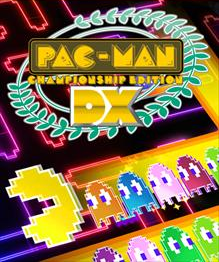
Pac-Man Championship Edition DX is a 2010 maze video game published by Namco Bandai Games for the Xbox 360 and PlayStation 3, later ported to Steam and iOS. It is the sequel to the 2007 game Pac-Man Championship Edition, which was the last game developed by series creator Toru Iwatani. The player controls Pac-Man as he must eat all of the dots in the maze while avoiding colored ghosts that pursue him. A bonus item will appear once the player has eaten all dots on one side of the maze, causing the layout to change. Several additions were made over the original, such as bombs that send all ghosts to the regeneration box and sleeping ghosts that will give chase when Pac-Man moves past them.
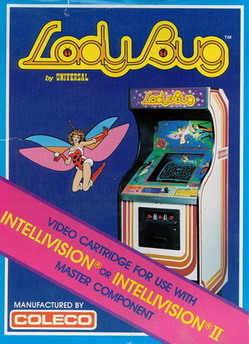
Lady Bug is a maze chase video game produced by Universal and released for arcades in 1981. Its gameplay is similar to Pac-Man, with the primary addition to the formula being gates that change the layout of the maze when used, adding an element of strategy to the genre. The arcade original was relatively obscure, but the game found wider recognition and success as a launch title for the ColecoVision console.

World's Biggest Pac-Man is a browser game created by Australian website designer Soap Creative along with Microsoft and Namco Bandai Games. It is a Pac-Man game which differed from the original by having multiple players play together in a series of user-created, customizable and interlocking mazes. The game was announced at the Microsoft MIX Developer Conference on 13 April 2011.

Pac-Man Championship Edition 2 is a maze arcade game in the Pac-Man series which was released for PlayStation 4, Windows, and Xbox One on September 15, 2016; an updated version featuring an exclusive 2-player co-op mode, Pac-Man Championship Edition 2 Plus, was released for Nintendo Switch on February 22, 2018. It was developed and published by Bandai Namco Entertainment, and is a direct sequel to Pac-Man Championship Edition, making it an indirect follow-up of Pac-Man Championship Edition DX+.

Pac-Man All-Stars is a video game for Microsoft Windows developed by British studio Creature Labs and published by Infogrames in 2002. It is a multiplayer video game where players control their characters to run around in different arenas to collect the most dots. The game is an enhanced version of the multiplayer mode found in Ms. Pac-Man Maze Madness and Pac-Man: Adventures in Time.

Pac-Man 99 is a maze video game with battle royale elements developed by Arika and published by Bandai Namco Entertainment for the Nintendo Switch. It was released through the Nintendo Switch Online service on April 7, 2021.




















